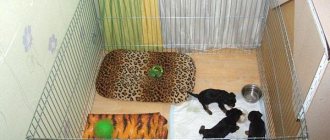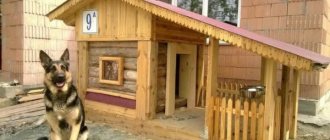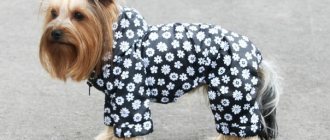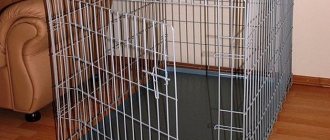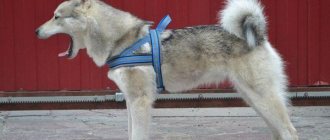When choosing a Labrador as a family pet, you need to remember that they need to be housetrained from puppyhood. If the puppy is accustomed to running freely around the courtyard of a personal plot and a city apartment, then in the future he will perceive further life in a kennel as a punishment.
Due to the friendly nature of Labradors, it is difficult to imagine them as a vigilant watchman or a reliable bodyguard. They are ideal for becoming a full-fledged member of the family, with whom you need to walk outside for a long time and play various games, otherwise the dog will lose its individuality and run wild.
Labradors are intelligent dogs that are strongly attached to their owners. They are easy to train, get along well with children and have an easy-going nature. It is no coincidence that a dog of this particular breed was given to Vladimir Putin.
The right booth for a Labrador
To do this, you need to meet a number of requirements:
- First, the floor must be made of hardwood. Signs of rotting, splinters and roughness are not allowed. To increase the service life of the boards, they must be treated with special chemical compounds that are harmless to animals.
- Secondly, it is recommended to make the walls double in order to install insulation in the partition, which is ideal for wood shavings or polystyrene foam. It is better to fasten wall boards together with self-tapping screws or screw nails, since the dog can get hurt on ordinary boards.
- Thirdly, it is advisable to make the roof pitched with a slope towards the drainage system, so rain and melt water will not accumulate around the booth. The flat roof can be used by the pet as an observation post for the surroundings. The roof structure can also be made in such a way that one of its edges can rise, helping to ventilate the interior. So that in your absence your pet has something to do, you can put his favorite toys in the enclosure.
Choosing a roof type
After calculating the size of the Labrador doghouse, you also need to decide on the type of roof. There can be two options: gable and flat. Each of the designs has certain advantages, so making a choice is not always easy.
Let's start with the flat one - it is the easiest to make. Therefore, many dog owners prefer it. In addition, dogs love to climb onto the roof of the booth and inspect their possessions from it, getting a greater overview. But it is worth remembering that a flat roof should be sloped so that water after rain or melting snow would rather roll down from it, rather than seep through the smallest cracks inside the booth.
The next option is gable. It is the most beautiful, but at the same time quite difficult to manufacture. In addition, not only rain, but also snow quickly drains or slides off such a roof, without causing unnecessary problems for the dog and the owner. In this case, you should make sure that there is a drainage ditch around the booth that drains excess water away, so as not to carry excess slush.
With this information, each dog owner will be able to decide which option is more suitable specifically for him.
How to determine dimensions for proper construction
The height of Labradors at the withers is about 55 cm, so it is necessary to select a booth taking into account that the dog can freely stand, sit or lie down. If a dog house comes with an enclosure, its total area should be approximately 8 square meters.
The parameters of the kennel are of great importance, since in a large space the pet will be too cold, and in a small space it will be too cramped. Therefore, the booth is built based on the parameters of the retriever. It is necessary to determine the personal dimensions of the retriever in order to build a custom-cut kennel.
Taking measurements correctly
- The height of the booth is based on the height of the retriever at the withers. To this is added the estimated height of the dog’s bedding, as well as about another 15 centimeters, so that the Labrador can move around the structure and sit without touching the ceiling with its head;
- The depth of the booth should be the length of the pet from the withers to the tips of the front paws and an additional 15 centimeters, this will allow the Labrador to sit comfortably inside;
- The width of the booth should be the length of the dog from the tip of the nose to the base of the tail. The vestibule of the booth is built much smaller, since the pet will stay in it for much less time;
- The height of the entrance should be less than the height of the animal by 9 centimeters from the withers, and the width should be the same;
Assembling the roof
Assembling the roof is the final stage of construction. For example, consider a flat or pitched roof, as it is easier to manufacture.
First, a frame is assembled from a block - its dimensions will be exactly the same as those of the bottom. Fasten it to the bars that form the frame of the walls. The task is not difficult - the main thing is that the screws do not go crooked and do not go inside the booth.
A piece of roofing felt or thick construction polyethylene is laid on top of the frame. This eliminates the possibility of rain or melt water leaking into the kennel, which means the pet will feel as comfortable as possible. If necessary, before laying waterproofing, you can use polystyrene foam, insulating the roof at the same time.
The last stage is laying the roof itself. Here you can use plywood or OSB board. The main thing is to make sure that it is strong enough to withstand the weight of your pet. In some cases, it makes sense to cut two sheets of the same size and connect them together, getting a really durable surface. The roof area can be larger than the kennel itself in order to reliably protect the dog from direct and slanting rain. And it will be much more pleasant for your pet to sit on a large roof than on a small one.
This completes the construction. Now you know how to make your own doghouse for a Labrador. The photos attached to the article will certainly help at different stages.
Booth material
Before starting construction, a loving owner will always begin to think not only about comfort, but also about the warmth in the room, but it is worth considering that there is not always a need to build a booth for cold periods, just the entrance and the main part where the pet will sleep is enough. The building should be erected not based on financial capabilities, but on an understanding of how comfortable the animal will be.
The most suitable material for construction will be coniferous wood, since this is what ensures air circulation, and therefore a favorable climate. In order to make the base of the booth from wood, it needs to be cleaned, this will protect it from splinters in the paws. Construction must begin with careful preparation. It is necessary to approach this issue thoroughly, since it is necessary to take into account any unforeseen issues, as well as financial expenses. In order to build a booth, you may need the following building materials:
- plywood;
- bars, their sizes are determined according to the parameters of the animal;
- batten;
- tarpaulin;
- roofing felt;
- slats;
- glassine;
- sand;
- tiles;
- Styrofoam.
Labrador kennel in the apartment
City residents who decide to purchase a Labrador as a pet dog often ask questions regarding keeping it in a city apartment. These retrievers are quite unpretentious in maintenance and, as their own place to rest, they perfectly adapt to life in a kennel or on a special bed. One of the conditions for their comfortable living in an apartment should be the absence of heating devices near their place of rest.
If a dog is accustomed to its own sleeping place from childhood, then in the future the dog will sleep there even in the absence of its owner.
It is highly not recommended to install a booth or bed for a Labrador on open loggias and balconies. Labradors have absolutely no fear of heights, and after jumping after a bird or seeing something interesting, the dog can jump out into the street.
And if there is a strong minus outside. Do you need to take your dog into a warm place?
First, let's define what kind of dogs we are talking about. We think that in most cases these are at least medium breeds weighing 10 kg or more. It is better not to take such dogs home in cold weather. Even when it’s -20 °C outside, even when it’s -30 °C and below. By taking your dog into a warm place - no matter in a house or a barn - you are still doing him the same disservice.
There is no need to worry about your pets. Nature has made them more perfect in terms of adaptability to external conditions. As cold weather sets in, their body is actively rebuilt: the animal’s undercoat grows, biochemical processes are optimized so that the necessary part of the energy is spent on heating. By keeping your animal warm, you disrupt the functioning of this delicate mechanism, which results in stress and discomfort for the dog. The best way you can show care in such a situation is through proper nutrition. In the cold season, the diet needs to be made more caloric or additional feeding should be introduced.
Construction stages
Bottom and base
The frame for the bottom is assembled from bars, then the floorboards are nailed. If the mass of the future resident is large, then you can additionally strengthen the bottom with a second layer of bars so that the floor does not sag. Bars are attached to the corners of the finished bottom; this will become the basis for the walls. The design should be similar in appearance to a dining table. Next, between the main bars, smaller bars are attached perpendicularly, this will help determine the future entrance.
Wall organization
In order to build walls, it is best to take clapboard. Since it does not have the ability to delaminate. The lining is secured to nails with small heads.
Ceiling
If the future booth will be located in an enclosure that is protected from the weather, then the structure of the ceiling is not necessary; it is enough to make an ordinary roof. However, if this is not provided, then it would not be superfluous to build both a ceiling and a roof. In order to make the ceiling you will need plywood.
Working on the walls
The next stage is making the walls. To begin with, the frame is traditionally assembled - for this, use the same bars. But they should be fixed to the bottom frame with longer screws. Better yet, use reliable corners. Then the rigidity of the structure will be maximum. At the same time, remember that on one side the bars should be higher, and the upper end should be cut at an angle - this will ensure a tight fit of the roof and at the same time guarantee the desired angle of the roof slope.
Now you need to line the inside walls with plywood or clapboard. The latter option is preferable - there will be no splinters here, which means that your pet will be much more comfortable living in the booth. Before covering the outside (here plywood can be used as a cheaper material), additional thermal insulation can be provided. The gap between the inner and outer cladding can be filled with suitable material - foam boards or ordinary small sawdust.
The casing should be secured with short self-tapping screws. Make sure that the caps are tightly recessed, but that the sharp ends of the screws do not stick out inside.
How to insulate a booth with your own hands
Of course, the owner selects the composition that is suitable for insulating the booth himself. However, it should be noted that not every material is suitable for a retriever. For example, mineral wool can cause irritation in a dog. Therefore, if you are building a kennel yourself with your own hands, it would be a good idea to consult with your dog’s veterinarian.
In any case, foam is safer. Before you begin insulation, the walls of the home need to be treated with antiseptic impregnation, then lay a layer of roofing felt, secure the layer with bars, lay out a layer of glassine, and only then lay out the insulation, on top of which a layer of glassine is again placed. After these steps, the paneling is secured and holes are made for the dog to enter and exit.
Booth entrance
In order to provide cold air to the booth, it is recommended to hang a canvas curtain at the entrance. To prevent the wind from opening the curtain, you need to sew small pockets on the bottom and fill them with sand.
Provided that the kennel for the retriever is made with your own hands, it is important to know that the above-mentioned antiseptic impregnations are very necessary, since without this, the structure may deteriorate within a year.
All of the above will help you make a home for your pet with your own hands. All that is needed is the desire to get down to business, the necessary equipment, drawings, dimensions and, of course, a four-legged friend. When building a house for a Labrador, the dimensions of the booth
will help you create the right drawing.
Where should I install it?
Once you have decided on the choice of design and selection of materials, it is very important to decide where exactly the booth will be installed. This is also an important factor. After all, not only the dog’s comfort, but also its ability to guard the territory depends on the chosen place.
Traditionally, the booth is located near a gate or gate. Thanks to this, the dog sees every person entering the owner’s territory. And can take appropriate measures. And strangers, seeing a large and determined dog near the gate, will once again think about whether it’s worth going in on their own or whether it would be better to wait for the owner to talk to him without entering someone else’s property.
However, you can use special fittings or a thick steel wire to which the chain is attached. This allows the dog to move freely along the entire fence - 10, 20 or even 100 meters. Very convenient. On the one hand, the booth can be placed anywhere, because the dog can easily reach it if the length of the chain allows. On the other hand, the risk of unwanted guests entering the site who decide not to use the gate, but simply climb over the fence, is reduced.
However, it’s worth keeping in mind that Labradors are generally very peaceful and friendly dogs. They are good companions and will make great playmates or walking companions. But they turn out to be good guards much less often. Simply because they want to be friends with the whole world, and not bark at strangers, much less bite them.
Finally, having determined what size kennel will be optimal for your Labrador, choose a place where the cozy house will be not only functional, but also comfortable. That is, on the one hand, the dog should have the opportunity to sit in the sun - on cold winter days this will be quite useful. On the other hand, there must be a shadow nearby. Here your pet will hide from the scorching summer sun in the heat. However, you can simply choose a place at random, and in the summer erect a small canopy that creates the shade your pet needs.
Place to install the booth
It is necessary to install a booth with an enclosure for a Labrador in a shady place from where the entire yard and surrounding area can be clearly seen, otherwise the dog will feel lonely and will irritate the owners and neighbors with its barking.
In order to begin building housing for your Labrador, you need to determine the correct location. The booth should not be located at the end of the territory, so the pet will not be able to see the entire territory and will worry about what is happening in the protected area. Such a place will cause your pet to bark.
A location near the fence will also not be the right decision; people passing by can irritate the pet and barking is inevitable. Those who keep pets in an apartment know very well that the animal only occupies those places where the entire area is clearly visible, even if sometimes it seems that the pet is just getting in the way. An excellent option would be booths built in the front zone. In this case, you need to choose a place that is not exposed to heat.
In order for the further stay of your pet child to go smoothly and comfortably, it is necessary to follow the main rules for the location of the booth:
- Firstly: the constructed kennel should not be exposed to drafts, so when building a kennel you should take into account in which direction the wind blows more often. This will help avoid many diseases and subsequent treatments. Agree, this is of no use;
- Secondly: every creature on earth loves light, so pay special attention to this criterion. The location of the future booth must be saturated with light, but it is mandatory to have a shadow where the pet can hide in hot weather;
- Thirdly: it is best to build a kennel on an elevated place, so during bad weather a puddle will not form near the dog’s home;
- Fourthly: from his home, the friend should be able to observe his post, as well as the front door and gate of the master's house.
Adviсe
When a home is made with your own hands, the work is not over. A dog's home requires proper care. Cleaning should be regular, about once or twice a month, at least. During cold seasons, cleaning should be done once a season. When cleaning the home, leftover food, bones and other unnecessary attributes are removed. The room is treated from the inside with preparations that disinfect and protect against parasites. After treatment, the pet should remain outside the booth until all treated walls are dry.
